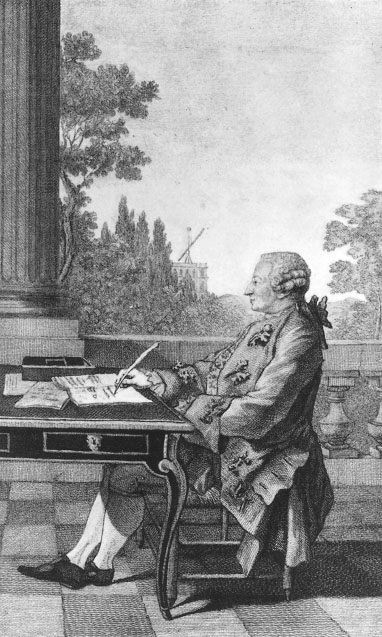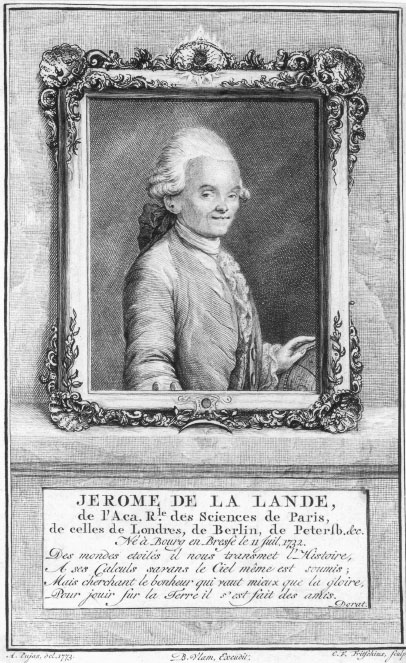When Computers Were Human (4 page)
Read When Computers Were Human Online
Authors: David Alan Grier


3a. Computers for first return of Halley's Comet: Alexis-Claude Clairaut

3b. Computers for first return of Halley's Comet: Joseph-Jérôme Le Français de Lalande

3c. Computers for first return of Halley's Comet: Nicole-Reine Ãtable de la Brière Lepaute
Joseph Lalande and Nicole-Reine Lepaute had an unconventional relationship that reflected the unconventional work in which they were engaged. Lalande never married; “he was a supremely ugly man,” wrote Alder, yet he “loved women, especially brilliant women, and promoted them in both word and deed.”
21
The two met when Lalande, acting as a representative of the Académie des Sciences, called upon Lepaute's husband and asked to examine the royal clocks. Lalande had been asked to prepare a report on clockmaking, and he returned regularly to the Lepaute apartment. He soon came to appreciate that Mme Lepaute had substantial mathematical talent and that her “astronomical tables were next to her household account books.” He asked Nicole-Reine Lepaute to prepare a table for his report on the royal clocks, a request that started a thirty-year collaboration. “She endured my faults,” wrote Lalande of his partner, “and helped to reduce them.”
22
Clairaut's computing plan was a step-by-step process that treated Jupiter and Saturn as if they were the hour and minute hands of a giant clock, ticking their way around the Sun. Each step of the calculation would advance the two planets a degree or two in their orbits. The procedure then required an adjustment of the orbits based upon the gravitational pull between the two planets and the sun. Saturn might be pulled a bit closer to the Sun, or Jupiter might be pushed forward in its orbit. On this celestial clock, the comet was a second hand that circled on a long, skinny ellipse in the opposite direction of the planets. The calculation of this orbit could be done after the calculations for Jupiter and Saturn, for though the two planets pulled on every step of the comet, the comet had no substantial effect on the planets. This part of the computation would advance the comet a small distance along the ellipse, compute the forces from the two giant planets, and adjust the orbit accordingly.
23
Lalande and Lepaute handled the first part of the computation, the three-body problem involving Saturn and Jupiter, while Clairaut took the orbit of the comet itself.
The three friends began their computations of Halley's comet in June 1757. They worked at a common table in the Palais Luxembourg using goose-quill pens and heavy linen paper.
24
Lalande and Lepaute worked at one side of the table and handed their results to Clairaut. Presumably, they wore the formal court dress of palace residents: coats and knee breeches for the men, a dress with underskirts for Lepaute, and powdered wigs for all. They would have begun their work late in the morning, as palace residents were rarely early risers. The computations would take
them through the early afternoon and into the evening, when dimming lights and fatiguing hands discouraged further efforts. At times, they would compute while they ate their meals. When servants appeared with food, the three would simply push their papers and ink pots aside to make room for the dishes and continue with their work.
25
In addition to stepping Halley's comet through its orbit, Clairaut took the responsibility of checking all of the calculations for errors. With three people contributing to the task, the project offered many opportunities for arithmetical mistakes. Identifying the source of such mistakes was difficult, and even a small error might be compounded in the calculations and ultimately render the final result meaningless. Critics of scientific research had pointed to such errors as a weakness of mathematical methods and suggested that numerical techniques were too fallible to capture the nature of the universe. Such critics included the English writer and social commentator Jonathan Swift (1667â1745), who attacked, in his satire
Gulliver's Travels
, both the general validity of mathematics and the specific accuracy of Edmund Halley's calculations.
Gulliver's Travels
appeared about thirty-five years before Clairaut began his computations. At the time of its publication, Halley had just become the Astronomer Royal of England. One section of the book describes an astronomer-king, much like Halley, who governs a mythical land of scientists called Laputa. In Laputa, the residents decorate their clothes with astronomical symbols and keep one eye turned always to the heavens. This astronomer-king eats food cut into geometrical shapes and gets so absorbed in calculation that he requires a servant to arouse his attention. His subjects are absent-minded, selfish, and contemptuous of practical issues. They “are dexterous enough upon a piece of paper,” the fictional Gulliver notes, “yet in the common actions and behaviour of life, I have not seen a more clumsy, awkward, and unhandy people.” They are deeply afraid of a comet, easily recognizable as Halley's, which they believe will destroy the earth in its next passage.
26
As Swift mocks the community of scientists, he directly attacks scientific calculation by equating the work of computation with the craft of a foolish and obstinate tailor. This tailor is asked to prepare a new suit of clothes for Gulliver and uses the full range of astronomical tools to create the pattern. Gulliver reports that the tailor “first took my altitude by a quadrant,” a device slightly larger than Halley's sextant, “and then, with a rule and compasses, described the dimensions and outlines of my whole body.” When Gulliver returns to accept the new clothes, he records that the tailor “brought my clothes very ill made, and quite out of shape, by happening to mistake a figure in the calculation.” The tailor makes no effort to correct the mistake, and Gulliver notes that “such accidents [occur] very frequently and [are] little regarded.”
27
In the summer of 1757, French translations of
Gulliver's Travels
could be easily found at Paris booksellers, though it does not seem to be the sort of book that Alexis Clairaut would have enjoyed. He had a methodical nature, one that would have carefully sought to avoid producing a suit of “clothes very ill made” or a cometary orbit ill calculated. He devised procedures that would check every step of the computation. Some values were double-computed; others were checked with graphs.
28
The equations themselves were checked with two preliminary calculations. Starting with observations from the 1531 return, the three workers computed a full orbit and compared the final positions of the comet with the data from 1607. After adjusting the equations, Clairaut, Lalande, and Lepaute repeated the process. Beginning with the 1607 observations, they calculated a second orbit and compared the final values with Halley's observations of the 1682 return.
29
These computations tripled the amount of work, but the process gave Clairaut, Lalande, and Lepaute a measure of confidence in their results.
The daily routine of computation, the effort to advance the comet eight or ten degrees in its orbit, tested the stamina of the three. “It is difficult to comprehend the courage which was demanded by this enterprise,” Joseph Lalande later wrote. He complained that “as a result of this hard work, I acquired an illness which, for the rest of my life, shall be with me.” By contrast, Nicole-Reine Lepaute carried her share of the burden without complaint. “Her ardor is surprising,” remarked Clairaut. Lalande confirmed this opinion, stating that “we would not, without her, have dared undertake this enormous work.”
30
The “enormous work” kept Clairaut, Lalande, and Lepaute busy at their computing table through late September. By then, astronomers were searching the night sky, expecting to catch the first gleam of the comet. Already several bodies had been falsely identified as the returning comet of 1682. Each passing day brought more pressure upon Clairaut, until he decided that he would have to increase the speed of the calculations. As the group began computing the last segment of the orbit, the part that came closest to the sun and planets, Clairaut simplified the equations by removing the terms that accounted for the gravity of Saturn. He believed that the influence of Saturn was small in that part of the orbit and that the revised calculation would still give a reasonable approximation of the comet's motion.
31
On the fourteenth of November, Clairaut presented the results to the Académie des Sciences. He predicted that the comet would reach its perihelion, the point closest to the sun, in mid-April. His calculations showed that the date would be April 15, 1758, but he knew that it was unlikely that the calculation captured perfectly the movement of the comet.
32
“You can see with what caution I make such an announcement,” he said, “since so many small quantities, which must be neglected in methods of approximation, can change the time by a month.”
33
His results suggested that the comet might round the sun as early as March 15 or as late as May 15.
For six weeks, the computation stood as a major accomplishment while astronomers watched and waited for the first observation of the comet. No sign of the comet was found in November and none in the first weeks of December, but on Christmas Day 1757, a German astronomer sighted the fuzzy glow of the comet nucleus. By the middle of January, enough observations had been made of the approaching body to show that the calculation had overestimated the date of the comet's arrival. The comet reached its perihelion on March 13, a few days outside of the interval that Clairaut had presented to the Académie des Sciences.
34
As the news of the discrepancy began to spread, astronomers started to assess the calculation and debate its meaning. The most public critic of the computation was French mathematician Jean Le Rond d'Alembert (1717â1783). D'Alembert was no social commentator in the manner of Jonathan Swift, but an established astronomer and an editor of the
Encyclopédie
, the French Enlightenment's grand catalog of knowledge. He argued that Clairaut's work was not based upon well-defined principles of scientific inquiry but was only a rough and unsubstantiated approximation.
35
He denounced what he called the “spirit of calculation” and claimed that the computation was more “laborious than deep.”
36
D'Alembert's criticisms sparked an extended argument among French scientists, an exchange that was fueled in no little part by the egos and ambitions of the two protagonists.
37
From the tenor of the debate, it seems clear that even Clairaut had more faith in Newton's theory of gravitation than in his own calculation of the comet's perihelion. Clairaut never suggested that Newton's theory needed to be adjusted to fit the prediction; instead, he returned to his figures and attempted to find some mistake that had caused the discrepancy. Under the best of circumstances, this is a dangerous endeavor, for there is a tremendous temptation to bend the equations in order to fit the data. With the perspective of modern astronomy, we know that Clairaut did not account for the influences of Uranus and Neptune, two large planets that were unknown in 1757. Without these planets, the equations could produce the correct date for the perihelion only if they misstated the influence of Jupiter and Saturn. Clairaut never took his adjustments that far, though he did produce a better prediction. A modern analysis of the result concluded that there were still many problems in the computation and that Clairaut benefited from the “fortuitous cancellation of opposing errors.”
38
After two
years of public rancor, Clairaut decided that he was tired of the debate, and he ended the controversy by begging d'Alembert, who clearly had no interest in large calculations, to “leave in peace those who did.”
39